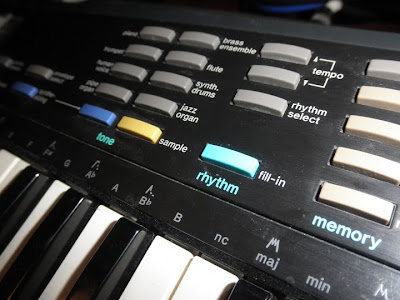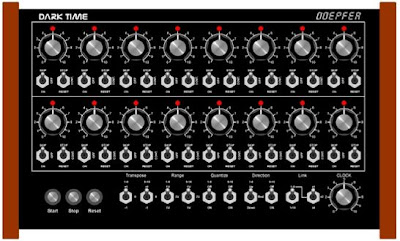
Monday, January 11, 2010
Live Techno Series #4 - MC-909 & Virus - Simon Stokes
YouTube via siedgey
"Thanks for checking this out!
This is part 4 of my new series of live techno videos. For this one, the track ended up being quite a bit harder and faster, but keeping the funk!
This is the same setup as the last video, with the 909 providing all the sequencing and percussion and the Virus providing all the sounds (created from scratch, of course!). The mad IDM type noise you can hear from the start of the track is created by setting the decay of a sound right down while it runs on the 16ths. This is then fed through the Virus' awesome tape delay, and the feedback amount is set to above 100% so it feeds into itself. Tweaking the delay time then makes everything go mental, as you can hear!
Hope you like it, all comments are warmly received. Please rate this video if you enjoy it - the last video quickly soared to the 35th top rated / most discussed music video on YouTube - so thank you to everyone who rated / commented!
If you have any questions, I'm always glad to help out.
Thanks,
Simon"
Gesture Controller
YouTube via alkopop79
"Gesture controlled music using infra red proximity sensors, Processing and Ableton Live."
Admin: Two Ways to Search the Site
I added the Google search box on the right. You can now use it and the top left Blogger search box. Note they are different and bring up slightly different results, so be sure to try both when searching for things.
NoDNA midi glove bend - Datenhandschuh, hör mir mal zu Teil 1
YouTube via Moogulator
"Ein Besuch bei NoDNA (C) www.sequencer.de synth database"
MIDI-Glove, Besuch bei No-DNA Teil 2
AC Power to the Electronic Music Studio
 A non synth post. Making the exception to this one as this pertains to how we power our synths. Via David Kronemyer:
A non synth post. Making the exception to this one as this pertains to how we power our synths. Via David Kronemyer:"It’s astonishing how many synth studios ignore the requisites of proper AC power. Power behind the racks typically is an afterthought. It ends up as a confused jumble of cables. This not only is conceptually offensive, but also results in marked degradation of audio sound quality.
Here is the solution we have implemented (see picture). We have six separate 20-amp AC lines coming into the studio from the main power service. First they go to Tripplite power conditioner-line stabilizers. These maintain the incoming voltage at a steady 120 V and also filter out noise, spikes and other undesirable artifacts. Then they go through a metering panel, which shows amperes – volts – watts. This gives a ready indication of each circuit’s capacity and status. Then they go to balancing transformers manufactured by Equi=Tech. Usually AC line voltage is 0 V on one leg and 120 V on the other. What balanced power does is change this to 60 V on both legs. This promotes common-mode rejection (analogous to balanced audio cabling) and lowers the noise floor by at least 10dB. It also eliminates ground loops (audible as 60 Hz hum) and complex star-grounding schemes. We can turn our main mixing system all the way up without audible hiss or noise. Oversized cabling is used throughout to reduce impedance and promote headroom. We also have uninterruptible power supplies for computers (not depicted).
Here are a few other observations:
1. Most studios have at least three separate cabling systems (AC, audio, MIDI). Power cabling should be physically separated from audio and MIDI. If they run parallel, there should be space between them; if they cross, they should do so at right angles. These same principles apply to digital cabling, computer cabling and time-code cabling.
2. Power to anything but sound-producing keyboards or modules must be on a completely separate AC circuit. Lighting and computers, for example, always should be on their own lines (as seen in the picture, four circuits are devoted to audio and two circuits to non-audio). It is difficult to over-emphasize the importance of this step. Back in the days of 24-track analog tape recorders, we even went so far as to rewire them, segregating power to the electronics from power to the motors. This considerably improved the sound of the electronics, because they did not have to deal with motor factors such as torque and slew. It also improved the performance of the motors, because now they could have a consistent power source without also worrying about powering electronic components.
3. Multiple wall-warts of the same power type (e.g. 12 VAC) easily can be replaced with a single, larger AC transformer. This provides consistent power to all of them and results in significantly improved sound quality. Many modules are 9 or 12 VDC. We have two large transformers (made by Acopian) to make these conversions, then distribute the power along separate lines, to the same effect.
In conclusion, studios typically spend thousands of dollars on gear while at the same time ignoring basic principles of how to make it sound good. This doesn’t make a lot of sense because the way things sound is constrained by the least-satisfactory variable. It’s important to optimize every step of the process in order to achieve a desirable outcome."
Pro One with SK-1.mov
YouTube via smoovbasket
"Demonstrating a Sequential Circuits Pro One. Its synced to a Casio SK-1 thru the audio in. Seq 1 is programmed to Rock, and Seq 2 is programmed to Disco. +1 Tempo."
 See this post for the lighted mod wheels.
See this post for the lighted mod wheels.

NAMM: Doepfer Dark Time Sequencer
 This one appears to be making the rounds. It will not be shown at NAMM, but it has been informally announced.
This one appears to be making the rounds. It will not be shown at NAMM, but it has been informally announced. "This sequencer is not shown at NAMM as we could not finish the prototype in time. In the first place it is planned as an analog sequencer for DARK ENERGY (same design and dimensions) but can be used in combination with other devices too.
It features 16 steps with on/off, skip, reset and stop switches for each step. Different modes are are available: 16 steps, 2 x 8 steps and different repetition modes. It has available CV/Gate outputs, Midi and USB. It is equipped with an internal clock oscillator but can be synced to Midi clock as well.
Features like transpose, direction (forward/backward/random), quantize on/off and ranges switches are planned."
NAMM: MMA to Present HOT (Hands-On-Training) MIDI Sessions at NAMM
via MIDI.org:
"NAMM has invited various partner organizations (like MMA) to rethink, rebuild and plan for the future of the music products industry by participating in the new H.O.T. (Hands-On Training) Zone on Level 2 of the Anaheim Convention Center.
More than 15 industry partners, publishers, organizations and associations will offer FREE training seminars, face-to-face meetings, networking opportunities, and one-on-one mentoring to strengthen the knowledge base of industry colleagues.
We'll be showing how MIDI technology is making playing, creating, and learning about music easier and more rewarding. See below for more info on the MIDI Sessions at The NAMM Show 2010."
via Steve Turnidge of SYNTHWERKS and AES PNW
"NAMM has invited various partner organizations (like MMA) to rethink, rebuild and plan for the future of the music products industry by participating in the new H.O.T. (Hands-On Training) Zone on Level 2 of the Anaheim Convention Center.
More than 15 industry partners, publishers, organizations and associations will offer FREE training seminars, face-to-face meetings, networking opportunities, and one-on-one mentoring to strengthen the knowledge base of industry colleagues.
We'll be showing how MIDI technology is making playing, creating, and learning about music easier and more rewarding. See below for more info on the MIDI Sessions at The NAMM Show 2010."
via Steve Turnidge of SYNTHWERKS and AES PNW
NAMM: An evening celebrating vintage keyboards through documentary film
 "At Winter NAMM 2010
"At Winter NAMM 2010Dianna Dilworth, Amin Bhatia and Michelle Moog-Koussa invite you to:
An evening celebrating vintage keyboards through documentary film
January 15th from 6-8pm
Avila Room at the Anaheim Hilton
The Making of Bolero Electronica
Neo-symphonic synthesist Amin Bhatia (Virtuality, Interstellar Suite) and Michelle Moog-Koussa, Executive Director of the Bob Moog Foundation host a question and answer session followed by a screening of a short documentary on the making of Bhatia's innovative realization of Bolero Electronica, for which he used over 70 synthesizers covering 75 years of evolution in synthesis in music.
Mellodrama: The Mellotron Movie
Following Bhatia, Dianna Dilworth and Markus Resch of the Mellotron Archive will screen Mellodrama: The Mellotron Movie which explores the rising and falling fortunes of the Mellotron – the first musical keyboard to “sample” the sounds of other instruments – from its birth in a California garage in the 1950s, through its dominance on concert stages in the 1970s, through its almost religious cult of followers in the 2000s.
Please come and join us for this very special evening ~
www.moogfoundation.org
www.aminbhatia.com
www.diannadilworth.com"
Also see this post and this post.
PREVIOUS PAGE
NEXT PAGE
HOME













© Matrixsynth - All posts are presented here for informative, historical and educative purposes as applicable within fair use.
MATRIXSYNTH is supported by affiliate links that use cookies to track clickthroughs and sales. See the privacy policy for details.
MATRIXSYNTH - EVERYTHING SYNTH













© Matrixsynth - All posts are presented here for informative, historical and educative purposes as applicable within fair use.
MATRIXSYNTH is supported by affiliate links that use cookies to track clickthroughs and sales. See the privacy policy for details.
MATRIXSYNTH - EVERYTHING SYNTH




























